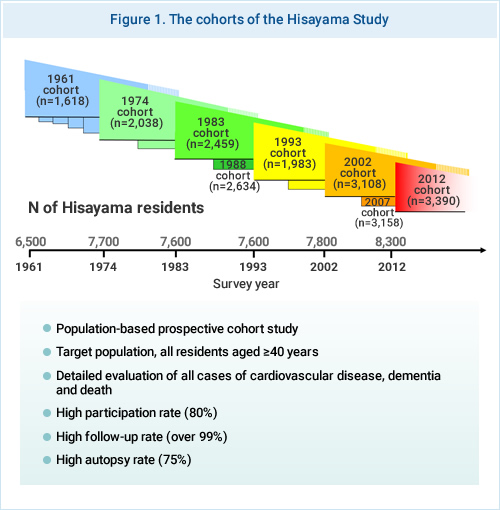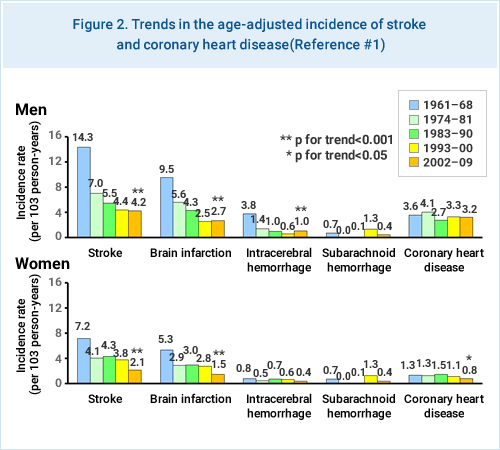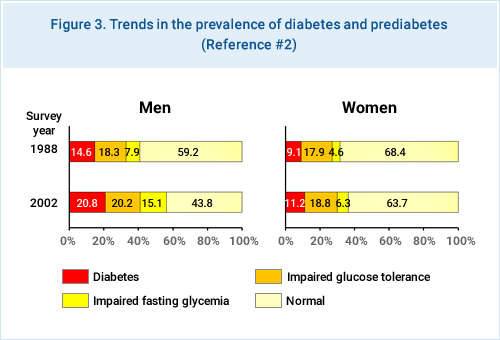HOME > Trends in cardiovascular diseases and diabetes mellitus
Trends in cardiovascular diseases and diabetes mellitus
The cohorts of the Hisayama Study

The Hisayama Study is a population-based prospective cohort study designed to evaluate the risk factors for lifestyle-related diseases in a general Japanese population. The prospective follow-up surveys have been conducted in subjects aged 40 years or older since 1961. To date, cohorts have been established in 1961, 1974, and every 4-5 years thereafter (Figure 1). A maximum effort has been made to include 70-80% of all residents aged 40 years or older in each of these cohorts, and each cohort has had a high follow-up rate of 99% or over and used the same follow-up procedures. Moreover, one of the most important characteristics of the study is that the average rate of autopsy examination among decedents in this town has been approximately 75% over the last 57 years. The major research subjects of this study are cardiovascular diseases (i.e., stroke and coronary heart disease), dementia, hypertension, diabetes, metabolic disorders, kidney disease, and gastrointestinal cancer.
The study participants have been followed-up prospectively via regular health examinations. Regular health examinations are repeated every 1-2 years to obtain information on individual health conditions, including cardiovascular events and dementia. Physical and biomedical characteristics ― namely, blood pressure, diabetic status, anthropometric measures, electrocardiogram, urinalysis, and blood tests ― are collected in the health examinations. For participants who do not undergo regular examination or who have moved away from town, mail and telephone follow-ups have been used for approximately the last 50 years. The health information of participants is also collected through a daily monitoring system established by the study team, local physicians, and the members of the town’s Health and Welfare Office. In this system, the physicians in the study team visit clinics, hospitals, and the town’s office regularly in order to collect information on events of cardiovascular disease and dementia, including suspected cases.
Trends in incidence rates of cardiovascular diseases

Cardiovascular disease is one of the leading causes of death worldwide. According to the vital statistics, Japanese populations had a higher mortality from stroke and a lower mortality from coronary heart disease than Western populations in the 1960s, and the mortality from stroke started to decrease in the 1970s. Lifestyle changes and improvement of prevention and management of cardiovascular risk factors in Japanese are likely to affect the incidence and mortality of cardiovascular disease. However, there have been few studies estimating the secular change in the incidence of cardiovascular disease in Japan over the past half century.
The Hisayama Study investigated this issue using the 7-year follow-up data from five cohorts, which were established in each decade from the 1960s to the 2000s and consisted of residents aged 40 years or older in a Japanese community (Figure 2). The age-adjusted incidence of stroke decreased steeply, by 51% in men and 43% in women, from the 1960s to the 1970s, but this decreasing trend slowed down in the subsequent decades.Similar downward trends in the incidence of brain infarction in both sexes and the incidence of intracerebral hemorrhage in men were observed. With regard to coronary heart disease (myocardial infarction, sudden cardiac death within 1 hour after the onset of acute illness, or coronary artery disease followed by coronary artery bypass surgery or angioplasty), there was no significant secular change in the age-adjusted incidence of coronary heart disease over the period in men, but it decreased significantly from the 1980s to the 2000s in women. However, the incidence of acute myocardial infarction did not decrease in either sex.
From the 1960s to the 2000s, the management of blood pressure improved significantly and the frequency of current smoking decreased in our study population, whereas the prevalence of metabolic disorders, such as glucose intolerance, hypercholesterolemia, and obesity, increased significantly with time. These changes in the status of cardiovascular risk factors would have strongly affected the risk of cardiovascular disease and its subtypes during the past half century among Japanese.
Trends in prevalence rates of diabetes and prediabetes

The rising prevalence of diabetes mellitus is a great public health concern, because diabetes mellitus can lead to complications in several organ systems, including both macro- and micro-vascular complications. Reliable estimations of secular changes in the prevalence of diabetes mellitus are necessary to develop effective strategies for prevention and management of diabetes mellitus. However, there are limited data addressing the trends in the prevalence of diabetes mellitus, which is defined using a 75-g oral glucose tolerance test (OGTT), in general Asian populations.
The Hisayama Study investigated secular trends in the prevalence of diabetes mellitus and prediabetes, defined using the 75-g OGTT, from 1988 to 2002 in a general Japanese population (Figure 3). The results showed that the secular trends in the age-adjusted prevalence of diabetes mellitus and impaired fasting glycemia (IFG) increased over a 14-year period in both sexes, whereas the increasing trend in the prevalence of impaired glucose tolerance (IGT) did not reach a statistically significant level in either sex.
References
- 1. Hata J, et al. Circulation 128: 1198-1205, 2013.
- 2. Mukai N, et al. J Diabetes Invest 5: 162-169, 2014.






